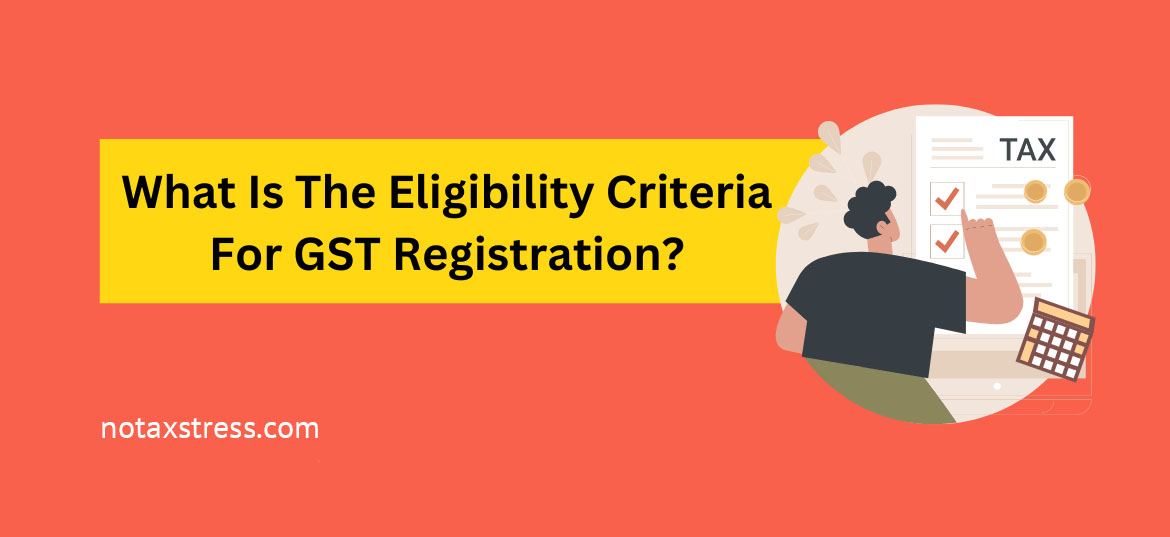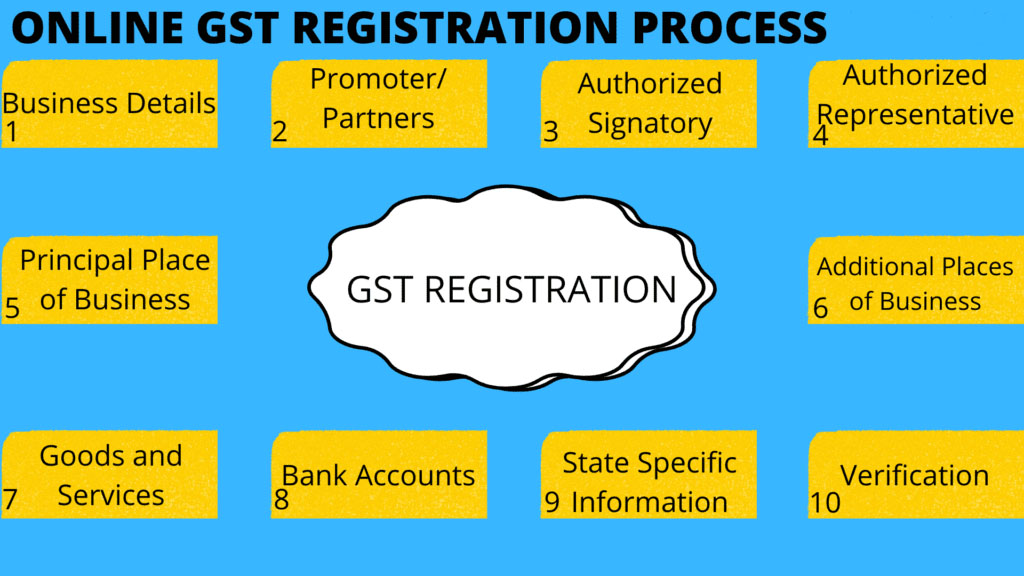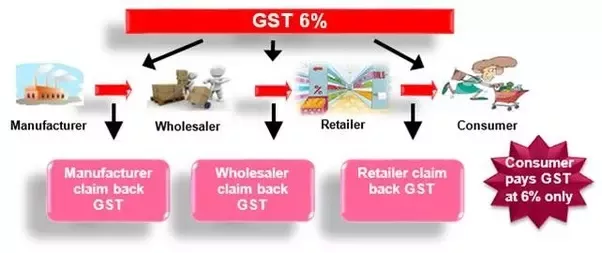GST Registration in India was introduced in India w.e.f. 1st July 2017. Goods and service tax (GST) is a successor to VAT used in India on the supply of goods and services. GST is a digitalised form of VAT where you can also track the goods & services. Both VAT and GST have the same taxation slabs. It is a tax on goods and services sold domestically for consumption. The tax is included in the final price and paid by consumers at point of sale and passed to the government by the seller. The GST is usually taxed as a single rate across a nation
Table of Contents

What is Goods and Service Tax (GST) ?
Goods and Services Tax (GST) is an indirect tax that was introduced in India w.e.f. 1st July 2017, which replaced all the existing indirect taxes like Central Sales Tax (CST) , Value Added Tax (VAT), Service Tax, Central Excise Duty, and others. GST is a comprehensive tax levied on the supply of goods and services across India. The introduction of GST has led to the simplification of the Indian tax system, seamless flow of Input Tax Credit (ITC) , reduction of tax evasion , and increased compliance.
How many types of Goods and Service Tax (GST ) – Dual Tax Structure
In India, GST is divided into three categories:
- Central GST (CGST)
- State GST (SGST
- Integrated GST (IGST).
CGST, SGST, and IGST are key components of India’s Goods and Services Tax (GST) system, which was introduced to simplify the complex tax structure that previously existed and create a unified tax system. These components represent the different layers of taxation under GST and help streamline the collection of taxes on the supply of goods and services. Let’s explore each of these components:
- CGST (Central Goods and Services Tax):
- CGST is the tax collected by the Central Government of India on the supply of goods and services within a single state.
- It is part of the dual tax structure, where both the Central Government and State Governments have the authority to levy and collect taxes on intra-state supplies.
- The revenue collected under CGST goes to the Central Government’s treasury.
- SGST (State Goods and Services Tax):
- SGST is the tax collected by the State Government of India on the supply of goods and services within a single state.
- Like CGST, SGST is part of the dual tax structure for intra-state supplies.
- The revenue collected under SGST goes to the respective state government’s treasury.
- IGST (Integrated Goods and Services Tax):
- IGST is the tax collected by the Central Government when goods and services are supplied across state borders or from one Union Territory to another.
- It is applicable to inter-state supplies, and the revenue collected is shared between the Central and State Governments.
- The key feature of IGST is that it helps prevent tax evasion and ensures that the revenue is shared equitably among the states. Under IGST, the tax is levied at the destination state, which means that the state where the goods or services are consumed receives the tax revenue.
Here’s a simple breakdown of how these components work:
- For intra-state supplies (i.e., transactions within a single state), both CGST and SGST are applicable. The total GST rate is divided into equal parts, with one part collected as CGST and the other part as SGST. This revenue is retained by the respective governments (Central and State).
- For inter-state supplies (i.e., transactions between states or Union Territories), IGST is applicable. The tax collected under IGST goes to the Central Government, and then it is distributed to the destination state where the goods or services are consumed.
- Input Tax Credit (ITC) can be claimed on both CGST and SGST paid on purchases for businesses operating within a single state. However, for inter-state transactions (under IGST), businesses can claim ITC on the entire IGST amount paid.
These three components, CGST, SGST, and IGST, are instrumental in creating a uniform and simplified tax structure, preventing the cascading effect of taxes, and facilitating the ease of doing business across the country. Businesses operating in India need to understand and comply with these components to ensure proper tax collection and reporting under the GST system.
Who is required to register under GST and how can we take registration under GST ?
Any individual or entity engaged in the supply of services with a turnover of more than Rs. 20 lakhs (Rs. 10 lakhs for North-Eastern states) in a financial year ( i.e. if turnover from supply of services is more than Rs.20 lacs for the period 1st April,2022 to 31st March,2023) is required to register under GST.
Similarly any individual or entity engaged in the supply of goods with a turnover of more than Rs.40 lakhs (Rs. 20 lakhs for North-Eastern states) is required to register under GST.
The registration process is completely online, and a unique 15 digit Goods and Services Tax Identification Number (GSTIN) is assigned upon successful registration.
The GSTIN is PAN based wherein first two digits specify the State Code , the next 10 digits are the PAN of individual or the entity, 13th digit is the no. of registrations taken in the same state , 14th digit will be “Z”, the last 15th digit can be number or an alphabet.
Eligibility for GST Registration
The eligibility for Goods and Services Tax (GST) registration in India is determined based on various criteria, including the type of business, annual turnover, and specific situations. here are the key factors that determine whether a business is eligible for GST registration:

- Business Type:
- Any individual or entity engaged in the supply of goods or services in India is generally eligible for GST registration. This includes businesses, self-employed professionals, manufacturers, traders, service providers, and e-commerce operators.
- Mandatory Registration:
- A business is required to obtain GST registration if its aggregate turnover (including the value of taxable and non-taxable, exempt, and export supplies) in a financial year exceeds the prescribed threshold limit. As of my last knowledge update, the threshold limit was set at ₹20 lakhs for most states, while for special category states, it was ₹10 lakhs. However, these limits may have changed, so it’s essential to check the current threshold applicable to your state.
- Special Category States:
- Some states and Union Territories in India are considered special category states, where the threshold limit for mandatory GST registration is lower (₹10 lakhs). It’s crucial to determine whether your business operates in one of these states.
- Casual Taxable Persons:
- Businesses or individuals that occasionally supply goods or services in a state or union territory where they do not have a fixed place of business may need to obtain GST registration as casual taxable persons.
- Non-Resident Taxable Persons:
- Non-resident taxable persons who supply goods or services in India are also required to register for GST, regardless of their turnover.
- E-commerce Operators:
- E-commerce operators that facilitate the supply of goods or services through their platform must register for GST, irrespective of their turnover.
- Input Service Distributors:
- Input Service Distributors (ISD) that distribute tax credit among their branches or units are required to obtain GST registration.
- TDS/TCS Deductors:
- Businesses that are required to deduct or collect tax at source (TDS/TCS) under the GST law must register as TDS/TCS deductors.
- Inter-State Suppliers:
- Businesses involved in the inter-state supply of goods or services are required to register for GST, regardless of their turnover.
It’s important to note that these criteria are subject to change based on updates in GST regulations. To determine your current eligibility for GST registration, it is recommended to consult us we can assess your specific circumstances and provide up-to-date information on the GST registration requirements applicable to your business.
GST Registration Process
Under GST, registered taxpayers are required to file periodic returns to the government, providing details of their sales , Input tax credit (ITC) on purchases & few other details. The frequency of filing returns varies depending on the type of taxpayer and turnover.

Although there are various returns to be filed by GST registered taxpayers however broadly , there are three types of GST returns: GSTR-1, GSTR-2A/GSTR-2B, and GSTR-3B which every registered taxpayer should know
GSTR-1 is a monthly or quarterly return filed by taxpayers to provide details of their outward supplies (sales).
GSTR-2A is a return that is automatically generated based on the purchases made by the taxpayer from registered suppliers.
GSTR-3B is a monthly return that summarises the details of both outward and inward supplies.

Online GST Registration in India.
We have Quick and Simple way to Kickstart your Business.
What is Input Tax Credit(ITC) and who can claim it?
Under GST, registered taxpayers can claim Input Tax Credit (ITC) for the tax paid on their purchases. ITC can be claimed only on purchases made from registered suppliers and used for business purposes. ITC cannot be claimed for personal or non-business expenses.
Who can file GST Annual Return ( GSTR-9/9C)?
Registered taxpayers with a turnover of more than Rs. 2 crores/Rs.5 crores are required to file their annual return in GSTR-9 before 31st December of following year (i.e. GSTR-9/9C for FY 2022-23 needs to be filed before 31st Dec,2023) declaring the summary of the Sales , Purchases & few other details. The reconciliation statement should be filed electronically in Form GSTR-9C.
Penalties for Non-Compliance with GST Provisions
Non-compliance with the GST provisions can attract heavy penalties. Penalties can range from Rs. 10,000 to 25,000, depending on the nature and severity of the default.
Conclusion
GST has brought about significant changes to the Indian tax system, simplifying it and increasing compliances and also it has changed the way a business used to operate in India. As an individual or any business entity who is doing business in India it is crucial to stay updated with the changes in the GST regime and ensure compliance.
Understanding the different aspects of GST, including registration, returns, ITC, audit, and penalties, is essential to ensure that there are no unnecessary huge fines & penalties on the individual or entity doing business in India.



Pingback: Highlights and Key Decisions from the 54th GST Council Meeting - No Tax Stress